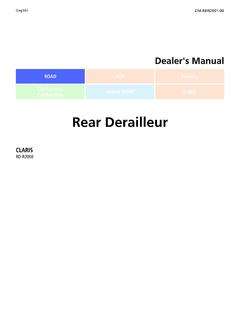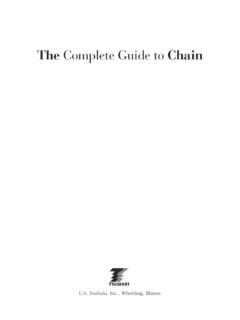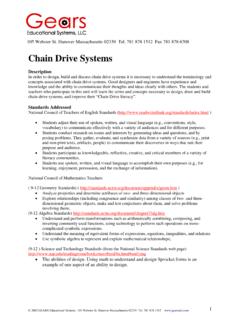Transcription of Roller Chain Drive Design - Cross+Morse
1 CROSS+MORSER oller Chain by nature of its Design is capable of transmittinghigh torque loads, and provides the ideal Drive media for theconnection of slow to medium speed shafts located on extendedcentres. The selection and application is reasonably simple byfollowing normal engineering practices, but there are points ofgood Design practice specific to Roller Chain Drives, andconsideration of these will ensure successful Drive Design . Numbers of Teeth in SprocketsChordal Action:- As a Chain engages and disengages with asprocket there is a rise and fall of each link, and a velocityvariation. These are due to chordal action caused by thechain forming a polygon on the sprocket . In the diagramsbelow as Roller B approaches the sprocket it follows thechordal line of Roller A. Once engaged it is caused to risefollowing the arc of the pitch circle. As the Chain unwrapsfrom the sprocket the reverse occurs. As well as inducing avibration into the Chain , the linear velocity of the Chain isvaried from a minimum on effective radius d to a maximumon the pitch circle radius r.
2 The level of this cyclic speedvariation can be determined:-Chordal velocity variation =100[1 Cos 180] %Zwhere Z =number of teeth in Chain Drive Design Drive RatioRoller Chain operates at high efficiency on drives with reductionratios up to 3:1, but can be used effectively for drives up to 5:1reduction. Higher ratios are not recommended but on some veryslow speed drives reductions up to 10:1 have been used. Highdrive ratios require sprockets with large number of teeth, whichrestrict maximum Chain wear with a resultant reduction in chainlife. For reduction ratios above 5:1 consideration should be givento two-stage Drive with idler shaft. Drive ArrangementsIt is preferred to use Roller Chain on drives with horizontalshafting, although vertical shaft drives can be centres may be displaced horizontal at an incline, orvertical, with each arrangement having its own specificrequirement. Horizontally displaced shafts, and drives withcentres inclination up to 60 , are the best and most commonarrangements.
3 On inclined drives the driver can be either above(as illustrated) or below the driven sprocket , but it is preferableto have the driving strand (tight side) of the Chain action is unavoidable, but its magnitude and effectcan be minimised by using sprockets with high numbers ofteeth, the value becoming insignificant on drives with 25tooth sprockets or Numbers of Teeth:- As most drives have a Chain with aneven number of pitches, using an odd number teeth in thesprockets will assist uniform wear distribution for bothchain and sprocket . An exception to this is for 1:1 ratio driveswhere even tooth sprockets are preferred to minimise theeffects of chordal action on the of Teeth in Large sprocket :- It is recommendedthat chainwheels should have a maximum of 114 teeth. Thislimitation is due to mis-matching of worn Chain with largesprockets which increases with the number of teeth in thesprocket. A simple formula to indicate percentage of chainwear a sprocket can accommodate is:-200%ZIt is considered good practice that the sum of teeth on drivesand driven sprocket should not be less than 50 and toreplace a Chain if wear elongation exceeds 2%.
4 For vertically displaced shaft drives, including drives with aninclination of over 60 to the horizontal, additional maintenanceis required to ensure Chain is always correctly adjusted, and forthis reason automatic means of Chain adjustment isrecommended for these arrangements. It is always preferred tohave the driver sprocket above the driven sprocket , as chainwear creates reduced contact on the lower Chain is not recommended for drives with verticalshafts, but providing the Drive is well engineered, and certainbasic rules followed, a satisfactory Drive can be achieved. Asthe Chain is supported by its side-plates on the sprockets, itis essential to use sprockets with high numbers of teeth(minimum 25 teeth) to spread the load. To minimisecatenary side loads on the Chain shaft centres should be keptto a minimum (30 pitches max), and multistrand chains usedwhere possible. For slow speed drives (up to 1 M/S) specialchain guides are available to support simplex Chain for longercentre drives.
5 It is imperative that chains are maintained incorrect tension at all times, if acceptable life is to beachieved, and to minimise the effects of wear, Chain selectionshould be made with an additional Design factor of +MORSE8 Useful formul :The following formul can be used in the Design and Selection of Chain Belt (kW) =Torque Nm rev/min9550 Belt/ Chain Speed (M/sec) =Z p ,000 Shafts Centre DistanceFor optimum Chain life shaft centres within the range 30 to50 times Chain pitch should be used, refer to page 9. Driveswith centres up to 80 times pitch will perform satisfactorilyproviding adequate adjustment of Chain tension is very long centres, consideration should be given usingtwo stage Drive with idler, or alternatively for lightly loaded,slow speed (up to 1 m/s) drives, supporting both strands ofchain on Chain Centre Drive usingSupporting GuidesRoller Chain Drive DesignLight live Roller conveyor drives can be powered using a singleloop of Chain with sprockets running on top.
6 The Chain shouldbe supported on plastic Chain guide to maintain constantcontact with sprockets, alternatively where rollers are wellspaced idler sprockets can be positioned opposite betweeneach pair of sprockets, this increasing the angle of contact onthe driven sprockets. The small contact between drivensprocket and Chain requires that torque on any one rollershould never exceed 15% of rated power for the Drive . Chainspeed should never exceed 1 m/s. An advantage of this layoutis that the driven sprockets and shafts can be easily removed. Centre Distance AdjustmentWhen designing a Chain Drive ability to adjust the position of oneshaft to compensate for Chain wear, should be included, ideallyequal to a minimum of 2 pitches of Chain . If this is not possible,correction for chainwear can be achieved by the incorporation ofadjustable idler or sprung loaded tensioner on the slack strand ofthe Chain . Automatic adjustment for Chain wear isrecommended for drives with an inclination of more than 60 tothe horizontal, see sketch.
7 Idler or tensioner sprockets should beapplied to the outside of the unloaded strand of the Chain closeto the driven sprocket , but allowing at least 5 pitches free lengthof Chain between idler and sprocket at all times. Ideally at least 3pitches of Chain should engage with idler sprockets. Automatictensioners cannot be used on reversing drives, or applicationswhere high torque reversals could be encountered. Idlers also arenot generally suitable for reversing DrivesTypical Serpentine DriveDrive to 7 pairs rollers in film process m/cRoller Chain is often used to connect a number of shaftswithin one Drive . Three arrangements are most drives have the Chain laced through a number ofsprockets, so that some can be driven contra-rotation to the drives suffer high rates of wear due to the number ofsprockets involved, and combined with necessary long chainlength require inclusion of an idler with a lot of adjustment,within the Drive . Sometimes a number of adjustable idlersare live Roller conveyors usually have the rollersconnected by coupled simple drives, often with the use ofdouble simple sprockets.
8 To keep Chain loads to a minimumit is preferable to connect input Drive to centre Roller , thiskeeping wear to a minimum. A simple Chain Drive operateswith an efficiency of 98%, therefore an allowance of 2%should be made for power loss in each loop of Chain indetermining Chain selection and Drive motor requirements. Elevated Temperature and StainlessSteel ChainsStandard Roller Chain loses some of its performancecapability at elevated temperatures, and also is more proneto corrosion problems. Hardness of pins and bushes becomereduced affecting operating life. At temperatures over 170 Cchain Drive capacity is reduced, and this must be included indrive selection by applying the factor f3 from the table Chain should not be used in temperatures over250 C. For elevated temperature applications it is preferableto select Stainless Steel Chains, with standard series suitableon applications to 325 C, and 300 series Chain fortemperatures to 500 C Stainless Steel Chain has lower wearresistance at all temperature, and therefore factor f3 in tableblow should be applied when making Chain f3(Stainless and Elevated Temperature)Z =No.
9 Teeth in sprocket or Pulleyp =Belt/ Chain pitch mmFurther Design formul and conversion tables areprovided in the catalogue Roller Chain300 Series Stainless-5 to 170 to 200 to 250 to 325 C to 425 C to 500 C +MORSE9 This selection procedure and the Chain ratings will providefor a life expectancy of 15,000 hours for drives whichincorporate a method of adjustment for wear, are operatingin a clean environment at normal ambient temperatures,and subject to proper maintenance and adequate lubricationat all times. In order to use the selection procedure it is firstnecessary to assemble all data relevant to the application,which should include:-a. Power to be Input shaft speed, and output speed required or Drive Type of driver and driven Centres and layout of Shaft ProcedureThe correct size of Chain for an application can be made byreference to Selection Charts relating shaft speed and designpower. The Design power Pd is determined from the motorpower P and application factors, f1, f2 and f3 if =P f1, f2 (f3)Where f1=Service Factorf2= sprocket Size Factorf3=Temperature Factoralso stainless steelchainsrefer to Page Service Factor - f1 The service factor f1 can be determined from details of thedriver and driven equipment by selection from the tablebelow.
10 The service factor is applied to take intoconsideration the source of power, nature of the load, loadinertia strain or shock, and the average hours per day ofservice. Normal duty drives are those with relatively littleshock or load variation. Examples of typical drivers anddriven equipment, are given at the bottom of the Chain Drive Selection2. sprocket Sizes - f2 The sprocket sizes are determined by the Drive ratio Ratio High Speed Shaft n1= Low Speed Shaft n2No. Teeth Large sprocket Z2=No. Teeth Small sprocket Z1 Suitable sprockets can be selected from Ratio Table Page 8with consideration given to the shaft speeds are very low it is advisable to use aminimum of 17 tooth sprockets. If the Drive operates at highspeeds or is subject to impulse load sprockets should have atleast 25 teeth and should be low ratio drives, sprockets with high numbers of teethminimise joint articulation, and bearing loads, thus extendingchain life. On drives where ratios exceed 5:1 the designershould consider using compound drives for maximum servicelife.







